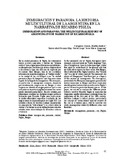Mostrar el registro sencillo del ítem
Inmigración y paranoia. La historia multicultural de la Argentina en la narrativa de Ricardo Piglia
| dc.rights.license | http://creativecommons.org/licenses/by-nc-sa/3.0/ve/ | es_VE |
| dc.contributor.author | Camperos García, Karlin Andrés | |
| dc.date.accessioned | 2020-11-20T15:08:27Z | |
| dc.date.available | 2020-11-20T15:08:27Z | |
| dc.date.issued | 2020-11 | |
| dc.identifier.issn | 0798-1570 | |
| dc.identifier.uri | http://www.saber.ula.ve/handle/123456789/47088 | |
| dc.description.abstract | En la ciudad paranoica de Piglia, los extranjeros tienen acentos marcados y hablan un “idioma exótico” que, al igual que el discurso esquizofrénico, oculta mensajes, verdades que deben comprenderse o descifrarse y que son difíciles de expresar por su emisor. Para Borges, uno de los escritores referentes de la poética pigliana, la “ciudad criolla” es la ciudad de los cuchilleros y no “la ciudad paranoica llena de húngaros” que funciona como legado de la llegada de inmigrantes. El extranjero, en particular el inmigrante europeo, despierta persistentemente suspicacias en Borges y estas suspicacias identifican rasgos poéticos que se ven reflejados en la poética pigliana al menos en ciertas piezas literarias particulares. En este estudio, nos planteamos analizar los distintos rasgos poéticos utilizados por Ricardo Piglia para representar la multiculturalidad argentina resultante de las migraciones de la primera parte del siglo XX. Los estudios críticos de Josefina Ludmer en particular su concepto de “isla urbana” y su crítica sobre la ciudad y la violencia serán utilizados para nuestro estudio, entre otros trabajos de diferentes críticos y teóricos. | es_VE |
| dc.language.iso | es | es_VE |
| dc.rights | info:eu-repo/semantics/openAccess | es_VE |
| dc.subject | Inmigración | es_VE |
| dc.subject | Paranoia | es_VE |
| dc.subject | Ciudad | es_VE |
| dc.subject | Piglia | es_VE |
| dc.subject | Borges | es_VE |
| dc.title | Inmigración y paranoia. La historia multicultural de la Argentina en la narrativa de Ricardo Piglia | es_VE |
| dc.title.alternative | Immigration and paranoia. The multicultural history of Argentina in the narrative of Ricardo Piglia | es_VE |
| dc.type | info:eu-repo/semantics/article | es_VE |
| dcterms.dateAccepted | Marzo-2020 | |
| dcterms.dateSubmitted | Marzo-2020 | |
| dcterms.publisher | SaberULA | |
| dc.description.abstract1 | In the paranoid city of Piglia, foreigners have strong accents and speak an “exotic language” that, like schizophrenic speech, hides messages, truths that must be understood or deciphered and that are difficult to express by their issuer. For Borges, direct referent of the Piglia’s poetics, the “Creole city” is a city of cutlers and not “the paranoid city plenty of Hungarians” that functions as a legacy of the arrival of immigrants. The foreigners, particularly the European immigrants, persistently arouse suspicions in Borges and these suspicions identify poetic features that are reflected in Piglia’s poetics at least in particular literary pieces. In this paper, we set out to analyze the different poetic features used by Ricardo Piglia to represent the Argentine multiculturalism resulting from the migrations of the first part of the 20th century. Josefi na Ludmer’s critical studies, particularly her concept of “urban island” and her reviews of the city as a violent space, will be used for our study, among other works by different critics and theorists. | es_VE |
| dc.description.colacion | 41-55 | es_VE |
| dc.description.email | cifranueva@ula.ve | es_VE |
| dc.description.email | karlincamperos@gmail.com | es_VE |
| dc.description.frecuencia | Semestral | |
| dc.description.paginaweb | http://www.saber.ula.ve/cifranueva/ | |
| dc.identifier.depositolegal | P P92-0047 | |
| dc.identifier.edepositolegal | ppi 201202ME4019 | |
| dc.identifier.eissn | 2244-8438 | |
| dc.publisher.pais | Venezuela | es_VE |
| dc.subject.institucion | Universidad de Los Andes | es_VE |
| dc.subject.keywords | Inmigration | es_VE |
| dc.subject.keywords | Paranoia | es_VE |
| dc.subject.keywords | City | es_VE |
| dc.subject.keywords | Piglia | es_VE |
| dc.subject.keywords | Borges | es_VE |
| dc.subject.seccion | Cifra Nueva: Artículos | es_VE |
| dc.subject.tipo | Artículos | es_VE |
| dc.type.media | Texto | es_VE |
Ficheros en el ítem
Este ítem aparece en la(s) siguiente(s) colección(ones)
-
Cifra Nueva - Nº 042
Julio - Diciembre 2020


